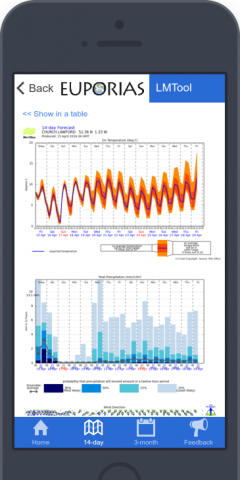Within the EUPORIAS project (7th EU Framework Program), a number of tailored climate services where developed for different sectors. Predictia participated in the development of some of them, such as the Land Management Tool, aimed at helping farmers in the south-east of the United Kingdom with their winter decisions. To do so, it provides seasonal predictions for next winter as well as weather forecasts for the next 14 days. All this information is provided either through the web or through a mobile app specifically developed for this service.
This work is presented an article, The land management tool: Developing a climate service in Southwest UK, which has just been published in the open-access journal Climate Services. The abstract of this paper is shown below:
Seasonal climate forecasts (SCFs) have significant potential to support shorter-term agricultural decisions and longer-term climate adaptation plans, but uptake in Europe has to date been low. Under the European Union funded project, European Provision Of Regional Impacts Assessments on Seasonal and Decadal Timescales (EUPORIAS) we have developed the Land Management Tool (LMTool), a prototype seasonal climate service for land managers, working closely in collaboration with two stakeholder organizations, Clinton Devon Estates (CDE) and the National Farmers Union (NFU). LMTool was one of several prototype climate services selected for development within EUPORIAS, including those for the UK transport network, food security in Ethiopia, renewable energy production, hydroelectric energy production in Sweden, and river management in two French basins. The LMTool provides SCFs (1–3 months ahead) to farmers in the Southwest UK, alongside 14-day site specific weather forecasts during the winter months when the skill of seasonal forecasts is greatest.
We describe the processes through which the LMTool was co-designed and developed with the farmers, its technical development and key features; critically examine the lessons learned and their implications for providing future climate services for land managers; and finally assess the feasibility of delivering an operational winter seasonal climate service for UK land managers.
A number of key learning points from developing the prototype may benefit future work in climate services for the land management and agriculture sector; many of these points are also valid for climate services in other sectors. Prototype development strongly benefitted from; working with intermediaries to identify representative, engaged land managers; an iterative and flexible process of co-design with the farmer group; and from an interdisciplinary project team. Further work is needed to develop a better understanding of the role of forecast skill in land management decision making, the potential benefits of downscaling and how seasonal forecasts can help support land managers decision-making processes. The prototype would require considerable work to implement a robust operational forecast system, and a longer period to demonstrate the value of the services provided. Finally, the potential for such services to be applied more widely in Europe is not well understood and would require further stakeholder engagement and forecast development.

